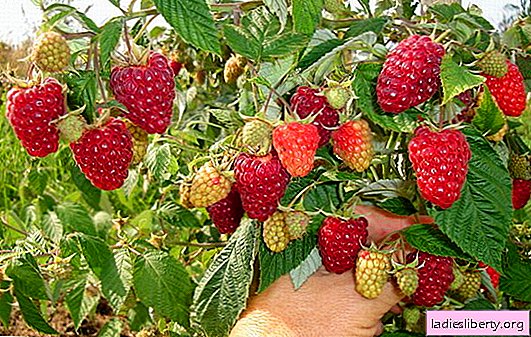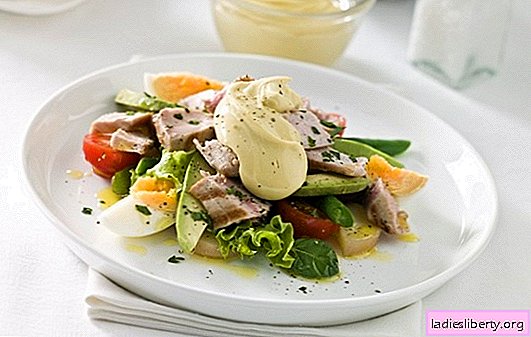
Raspberry is the most popular berry crop in the gardens of Russian gardeners.
But not always, it turns out, to achieve harvesting, filled with fragrant, tasty and healthy berries.
Since ordinary varieties of raspberries are often susceptible to diseases, pests, and in the winter season, the berry stands, preet and deteriorate.
In this regard, the cultivation of remont raspberries is preferred by gardeners.
Thanks to this type of culture, it was possible to increase the yield for the collection of fragrant berries, as well as improve its taste.
Repair raspberries and features of its cultivation
The variety of remontant raspberries bears fruit mainly on annual shoots. The name remontance comes from the French word - rise, replenish. In general, remontance is the ability to bear fruit for a long time.
The benefits of remont raspberries:
• Harvest from such a crop can be taken twice a year.
• The process of caring for remont raspberries is less time consuming than for other varieties of garden berries.
• To form a crop, remont raspberries require a year (other varieties two years), in connection with which it needs more nutrients, watering, heat and sun. The soil for remont raspberries is needed loose and fertile.
• During flowering, repair raspberries are not too susceptible to pests, as many of them already lose their activity during this period.
• Pests do not spend their wintering on branches of repair raspberries, as they are simply cut, which greatly facilitates the process of caring for this crop.
The main feature of remont raspberries is harvesting twice a year, which is very attractive for lovers of this berry. Gardeners harvest the first crop in August - September, and the next in June next year. True, the raspberry of the second harvest is not so large and a little bony, since the plant devoted its main forces to the ripening of the berries of the summer-autumn period.
Although you can easily get a good harvest from the second harvest, provided that you properly care for the remont raspberries and watering.
Repair raspberries: the best varieties
The berries of remontant raspberries of the best varieties by weight reach 15 grams. In practice, they can be compared with plums of rather large sizes, and from the bush you can collect up to 5-7 kg of crop. Berries have a good density, unmatched taste and color from yellow to ruby - red.
In Russia, more than 20 varieties of repairing raspberries, with different ripening periods, are registered. Here are some of them:
For central Russia, a berry culture called - yellow giant. This raspberry variety is characterized by high productivity, from the bush of which you can remove up to 6 kg of berries. The bush reaches a height of 2 meters, the sweet berries of which are very fragrant, and due to its yellow color are available to allergy sufferers and women in position. This variety has excellent resistance and resistance to frost and various diseases. It’s easy to take care of the “yellow giant”, you just need to regularly water the crop, harvest the crops on time, after which you need to cut the bushes completely to the ground so that the pests do not occupy the leaves and stems of the plant.
The most heat-resistant and drought-resistant variety of remont raspberries called "Bryansk divo". These rich red berries have a mass of 5-10 grams somewhat elongated. From one bush you can harvest up to 4 kg.
Important! Gardeners, relying on their own experience, in order for the berries to grow large, it is recommended to cut the lower branches with buds even before their flowering.
Raspberries called "Bryansk divo" should be planted in a sunny place, loose soil with top dressing in the form of humus or manure, as well as ash. Watering this variety is often not recommended, because of the possible rotting of the root system.
- Our Russian variety of remont raspberries called "Indian summer" best planted in the southern and central strip of Russia. The volume bush of this raspberry variety reaches a height of two meters. The first harvest of this raspberry variety occurs at the end of July, and the second occurs at the first frost. The berries of this variety of remontant raspberry burgundy color, round, small, each reaches three grams. From one bush of this raspberry variety you can collect up to 1 kg of berries.
This culture has excellent frost resistance and is practically not affected by diseases and pests.
- A repair raspberry variety called ruby necklace It is a mid-season crop with an elongated shape, ruby color and large fruits, reaching 6-7 gr.
Having a sweet and sour taste, this berry is suitable both for fresh consumption and after processing.
In order for the bush not to freeze before the appearance of berries, it is necessary to cut to the very ground.
- The most popular raspberry variety among gardeners is a remont raspberry called Polka. This repairing variety gives a huge harvest of up to 12 tons per hectare, since the fruits of this crop reach 12 grams.
This variety is absolutely not susceptible to pests and diseases. In addition, Polka begins bearing fruit from the middle of the summer period and does not stop bearing fruit until the onset of the coldest weather.
Bright red color, impeccable aroma and sweet and sour taste make this berry the most attractive in comparison with other varieties of raspberries.
Repair raspberries: planting, care (photo)

Achieve a rich harvest of varieties of remontant raspberries to gardeners, fans will help some of the knowledge necessary for its successful planting:
Any shady place with no sun can pretty much reduce the yield of this variety.
Landing must be carried out in a warm place near a house or other household buildings in order to protect raspberries from possible drafts.
If the climatic conditions are hot, then the bushes must be planted in cool places.
It is better to plant remontant raspberries in places where previously the berry did not grow, since the soil in such an area can be depleted, which will negatively affect the growth of young plants. Re-planting raspberries in the same soil is recommended no earlier than 5-7 years.
It is recommended to plant such varieties of raspberries to a depth of half a meter and add humus to each well to feed the bushes, but not too close to each other.
The care required for repair raspberries is, in principle, uncomplicated; after planting seedlings, it is most cost-effective to mulch foliage and needles. And it is best to skip the first harvest in the first year after planting so that the berry harvested in the second crop is larger and less bony. It is also necessary to carry out regular watering, weeding, fertilizing the soil under the plant.
Repair raspberries: top dressing, pruning
Only in the third year after planting raspberry seedlings, fertilizing with mineral fertilizers is required. After planting remontant raspberries, top dressing is necessary in the form of complex fertilizers containing phosphorus, nitrogen, potassium and other trace elements.

In the central zone of Russia, annual plants of remontant raspberries are cut almost at the end of autumn until the first frosts. But in some regions, pruning can be moved to the spring. After the buds begin to bloom, pruning will help the plant to receive the substances necessary for growth, which will accumulate in young leaves, which are so necessary for the plant for spring awakening.
In the autumn period after harvesting, two-year-old shoots after fruiting are removed at the very root. Through chur, overgrown bushes are freed from unnecessary twigs. In the spring, near the repairing raspberries, the upper branches are cut by 12-15 cm. Thanks to this process, raspberries are renewed and give the gardener an excellent harvest.
Repair raspberries: pests and diseases (photo)
Repair raspberries can be affected by pests such as:
• Aphid leaf. It feeds on raspberry leaf juice. To destroy the pest, korbofos is used.
• Aphids threatening shoots. Due to infection, raspberries stop growing.
• Spider mite. Because of this pest, the foliage begins to dry and dry. The culture must be treated with malathion, colloidal sulfur or other means.
There are also other equally dangerous pests - raspberry weevils, moth that infects the buds of a plant, stem fly, gall midges, raspberry beetle, raspberry glass.

Various diseases can also affect repair raspberries:
• Curly raspberries, a disease that affects shrub foliage.
• Mycoplasmosis, as a result of this disease, the shoots cease to bear fruit.
• Drying of raspberries resulting from improper care.
• Purple spotting, because of it branches and bushes become fragile and break.
• Powdery mildew, affects leaves and berries, which later dry up.
• Anthrancosis because of this fungus, the berries do not have time to ripen, begin to blacken.
Therefore, in order to preserve the repair raspberries from diseases and pests, she needs proper care and constant care.











